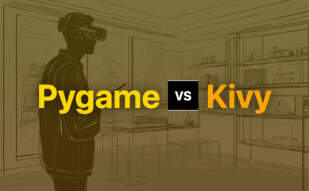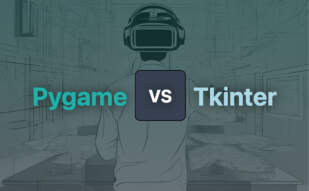Kivy is an open-source, Python-based framework designed for developing multi-touch applications with a natural user interface. It supports various platforms such as Windows, macOS, Linux, iOS, and Android, and is based on the Model-View-Controller (MVC) architecture.

For those exploring options beyond Kivy, alternatives to consider are Pygame, Tkinter, Pyglet, Arcade, Turtle, Love2D, and Unity.
Pygame

Enter the realm of Pygame, a powerful set of Python modules designed for creating video games. Authored by esteemed contributors, it has been shaping the gaming landscape since its first release in 2000, with the latest stable version 2.5.0 launched in June 2023.
Best Features of Pygame
- Comprehensive cross-platform capabilities catering to a variety of operating systems, including AmigaOS, Dreamcast, Atari, and RISC OS.
- Use of SDL library, which simplifies real-time game development tasks like vector math, pixel-array manipulations, or 2D sprite scene graph management.
- An inclusive, community-driven development model, cultivating a rich selection of tutorials and resources for users at all levels of expertise.
| Feature | Benefit |
|---|---|
| Adjustable scrolling speed | Allows for customization in game dynamics, enhancing player experience. |
| Handheld device compatibility | Expands gamer access, with Pygame running on nearly every operating system and devices including game consoles and OLPC computers. |
| Increased FPS control | Offers user precise control over the game’s speed, tailoring gameplay to suit individual preferences. |
Pygame Limitations
- Lacks setuptools or ctypes in Python, posing potential challenges in installation and usage
- While powerful, how Pygame’s performance compares with higher-level languages is yet unequivocal, considering the notable difference in execution speed.
Pygame Usage
As an open-source game development tool, Pygame can be employed free of charge to create freeware, shareware, and even commercial games.
Use Cases
Use case 1: Educational Tool
Pygame’s accessibility makes it an ideal learning tool for young kids, college students, and first-time programmers venturing into game development.
Use case 2: Commercial Game Development
Notable games like Frets on Fire and Dangerous High School Girls in Trouble have flourished under Pygame, demonstrating its applicability in the commercial sphere.
Use case 3: Mobile Game Development
With its compatibility with Android devices and supportive features like vibration and accelerometer, Pygame proves itself a robust platform for mobile game development.
Tkinter
When it comes to Python bindings to the Tk GUI toolkit, Tkinter is the de facto choice. A standard feature in Linux, Microsoft Windows, and macOS Python installs, it’s widely accessible, versatile, and allows for a mix of Python and Tcl commands in a single application.
Tkinter Top Features
- An array of Widgets such as frame, button, scrollbar, listbox, and more offer interface versatility.
- Uses object-oriented paradigm for better user experience.
- Features modules for pop-up dialogs like tk.messagebox, tk.filedialog, and tk.colorchooser enhancing functionality.
- ‘Themed Tk’ functionality to create native-looking applications.
| Feature | Description |
|---|---|
| Free Software | Tkinter is free software under the Python license, making it a cost-effective choice. |
| Customised Display Settings | These settings facilitate a better reading experience and user-friendly interface. |
| Compatibility | Being included with standard Python installs, Tkinter extends its utility across platforms like Linux, Microsoft Windows, macOS. |
Tkinter Limitations
- While Tkinter is versatile, there is a limit to the style and design aesthetics.
- For complex, large-scale projects, Tkinter may not be the best choice given alternatives like Kivy, Pygame, and PyQt.
Tkinter Pricing
As proudly affirmed in the Python community, Tkinter is open source and absolutely free. This matches the ethos of Python itself, breaking barriers to entry and encouraging development.
Tkinter Use Cases
Use Case 1: Prototypes
Due to its simplicity and standard library status, Tkinter is often used for prototyping applications and testing ideas quickly.
Use Case 2: Desktop Applications
Tkinter has been used to create numerous desktop applications given its wide range of widgets and straight-forward approach.
Use Case 3: Educational Use
Within educational settings, Tkinter is an excellent resource for teaching GUI development due to its simplicity and ease of access.
Pyglet
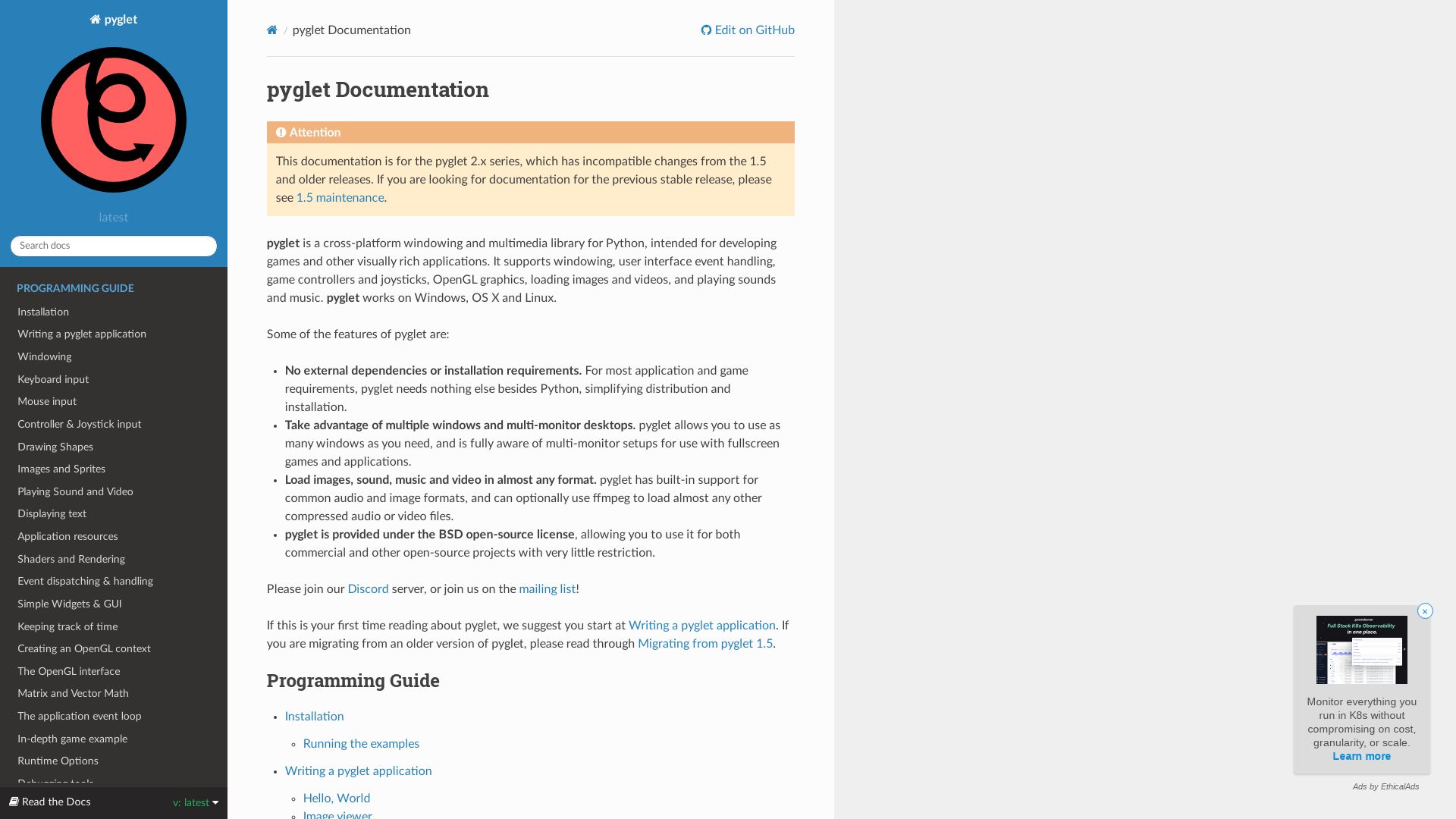
Treading on the revered path of Python’s eloquence, Pyglet emerges as an open-source virtuoso in the realm of game development. Aesthetically designed to empower versatile applications ranging from GUI development to multiplayer games, its web of support expands to Windows, Mac OS, and Linux.
Pyglet’s Top Features
- No external dependencies: The privilege simplifies distribution and multiplies ease of installation.
- Multimedia Handling: The ability to import images, audio, and videos in sundry formats.
- Advanced Batching: Offers superior performance by leveraging advanced batching for drawing thousands of objects.
- Multi-Window Advantage: Skillfully handles multiple windows and multi-monitor desktops for an elevated user experience.
| Feature | Description |
|---|---|
| License | Operates under a BSD open-source license, welcoming commercial and other open-source projects. |
| Compatibility | Harmonizes with both Python 2 and Python 3, while also being compatible with various Python GUI libraries. |
| Community Support | Enjoys the backing of a vibrant developer and user community ready to troubleshoot documentation or bugs. |
Pyglet Downsides
- While Pyglet is phenomenal in many aspects, the absence of inherent 3D support could discourage certain developers.
- The absence of an integrated physics engine might detract those seeking more comprehensive game development tools.
Pyglet Pricing
Behold the magnanimity of Pyglet – it is absolutely free. Under its gallant open-source license, it offers a treasure trove of features effectively costing you naught.
Pyglet Use Cases
Use case 1
For those crafting multimedia applications, Pyglet’s adept handling of various formats becomes a cornerstone.
Use case 2
In the sphere of game development, its proficiency in handling thousands of objects due to advanced batching provides a competitive edge.
Use case 3
Those developing on multiple platforms would find solace in Pyglet’s wide range of support, fostering productivity irrespective of the operating system.
Arcade

Bring life to the virtual world with Arcade, a modern Python module specifically designed for creating mesmerizing 2D video games with appealing graphics and sound. Brainchild of Paul Vincent Craven, a computer science professor at Simpson College, this powerful tool has the potential to revolutionize your gaming framework.
Best Features of Arcade
- Designed for Python 3.6+, and brings the power of type hinting.
- Compatibility across Windows, Mac OS X, Linux and requires OpenGL 3.3+ support.
- Empowers you with inbuilt drawing functions for circles, rectangles, polygons and more.
- Ready to leverage open-source free, shareware, and commercial games development.
- Object-oriented design for powerful class creation based on arcade.Windows.
| Improvement Over Pygame | Additional Feature |
|---|---|
| Bootstrap with minimal boilerplate code as it’s built atop the Pyglet multimedia library. | Effortless audio integration with load_sound, play_sound, and set_sound_volume functions. |
| Follows standard coordinate system and presents a superior detailed API documentation. | Unique sprite creation for spectacular animations and graphics. |
Arcade Limitations
- Limited Python version compatibility, only works with Python 3.6 or newer, does not support Python 2.x.
- Occasionally showcases instability issues and breaking changes with limited backward compatibility.
- Its interface often requires debugging using long examples and the documentation can lack detailed clarity.
Arcade Pricing
Arcade is an open-source dynamo! It surrenders itself to the realm of free, shareware, and commercial game development. Embrace this digital gem without shaking your budget.
Arcade Use Cases
Use case 1
The finesse of Arcade is a blessing for game developers who crave innovation and simplicity. Its power of creating diverse shapes combined with a barrage of features, allows you to holistically focus on creating engaging content without hassles of coding complexities.
Use case 2
An efficient tool for computer science educators. Arcade provides a real-world platform for students to learn and implement their theoretical skills. Its effortless integration into the curriculum creates an engaging and interactive learning environment.
Use case 3
Perfect for commercial game developers. Arcade comes with open-source perks yet gives the robustness and efficiency of commercial products. Its features and functionality empower the developers to create commercial-grade games without heavy investments.
Turtle
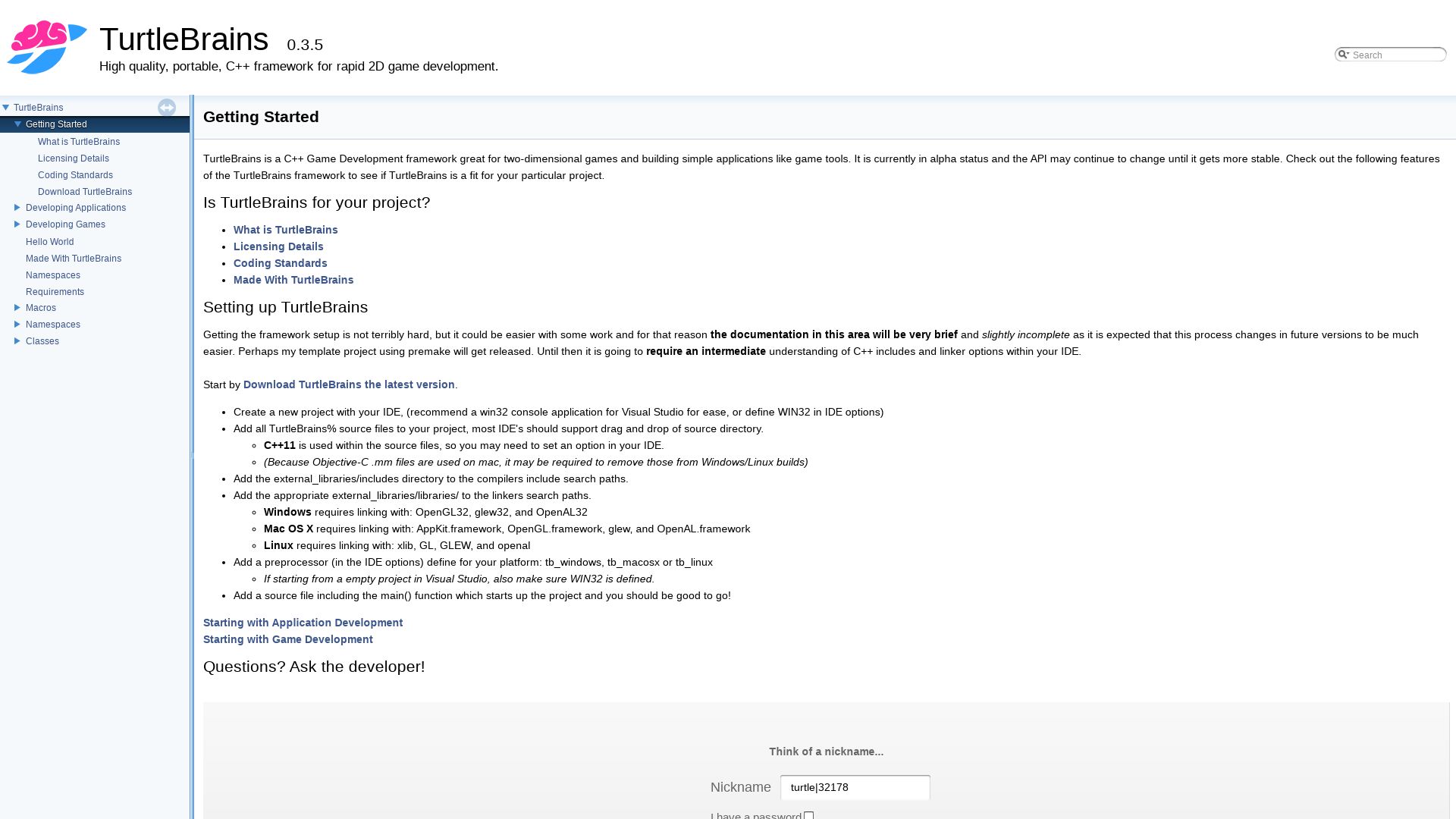
Emerging from the global hub of innovation, MIT, in the 1960s, Turtle Graphics has travelled a long arc to become an integral aspect of modern programming languages like Python. Originating from Seymour Papert’s Logo programming language, it provided an interactive, visual programming framework for children. Today, the Turtle takes the form of a virtual object, moving and drawing in response to sets of commands and offering a tangible way to observe the interplay of code and output.
Top Turtle Features
- Complete integration with Python syntax, data structures, control flows making it a powerful utility.
- Ability to draw intricate designs by harmoniously blending basic motions and varied angles.
- State of the pen is controllable, offering more flexibility in drawing parameters.
- The Turtle can extend its functionality to a three-dimensional coordinate model via cartesian-rotational graphics systems.
- Utility to generate complex geometric shapes, or patterns using loops and method subprocesses.
| Feature | Description |
|---|---|
| Geometric Drawing | Skilled at composing geometric shapes and patterns using command bundles. |
| Pen Customization | Users can freely control state of the pen, augmenting the diversity of drawings. |
| Three-dimensional Rendering | Capable of extending graphics to a 3D space for a more vivid visual experience. |
Turtle Limitations
- While the basic features introduce minimal overhead, the advanced Turtle capabilities can be quite intricate and potentially overwhelming for beginners.
- The educational roots of Turtle Graphics may limit its attractiveness for advanced users looking for more sophisticated graphics libraries.
Turtle Pricing
As Turtle comes as part of Python’s standard library, it is accessible free of charge, substantiating its position as an excellent tool, especially for beginners.
Turtle Use Cases
Use Case 1: Educational
Young minds eager to voyage into the world of programming find a loyal companion in Turtle. Its ease of use, tangible results, and the combined introduction to Python fundamentals make it an ideal learning tool.
Use Case 2: Programming Training
A jumpstart choice for individuals learning Python. The interactive, visual programming interface serves as a gentle and enjoyable initiation into the universe of Python.
Use Case 3: Basic Graphics Design
When programmers need a result-oriented graphical output without engaging with complex external libraries, they turn to Turtle. It serves efficiently for basic sketches and even some complex geometric shapes.
Love2D
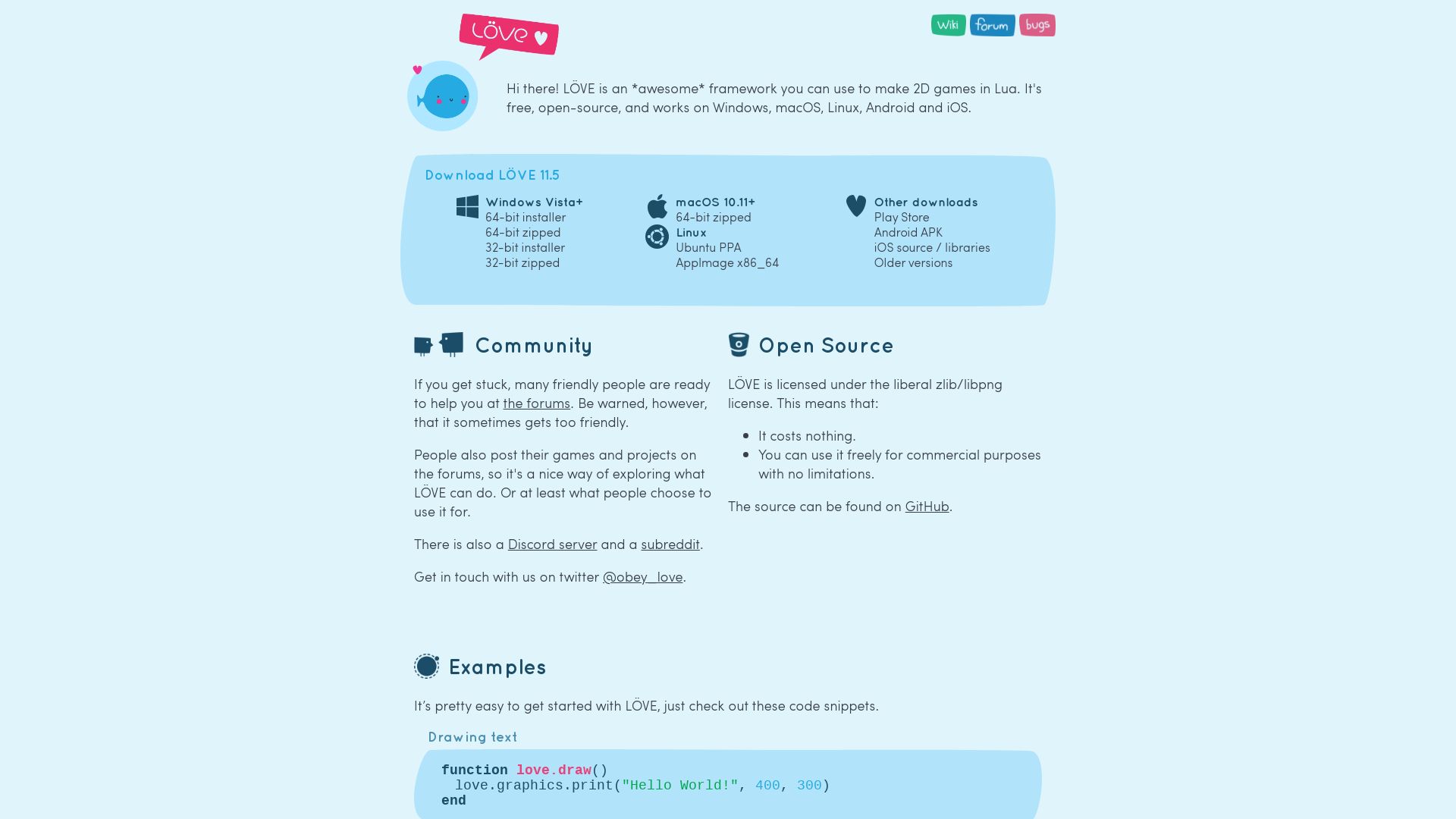
Let’s delve into the world of Love2D, a free open-source game framework initially released back in 2008. Written in C++, this game development software is popularly recognized for its compatibility with diverse platforms and its ease of use courtesy of the Lua scripting language.
Love2D Top Features
- Wide Platform Compatibility: From FreeBSD, OpenBSD, NetBSD to Windows, Linux, macOS, iOS, Android, Love2D supports them all.
- Supports Multiple Formats: The software works well with a variety of audio formats such as WAV, OGG, and MP3, and image formats including PNG, JPEG, GIF, TGA, and BMP.
- Additional Functionality: Love2D provides access to video and sound functions, while also supporting OpenGL pixel shaders GLSL, touchscreens for mobile devices, and joystick controls.
| Feature | Description |
|---|---|
| Library Compatibility | Compatible with libraries SDL, OpenGL, and eminent forks such as Simple Tiled Implementation library and anim8 library. |
| Physics Engine | Incorporates the formidable physics engine, Box2D, and LuaSocket library for network communications. |
| Community Support | Access to abundant community support via the official Discord server, IRC channel, and issue tracker. |
Love2D Limitations
- Specifically designed for 2D games, the engine cannot offer the same level of power as more advanced game development software like Unreal or Unity.
- Limited by its modules, Love2D does not have a graphical interface which could alienate those used to an interface-based design process.
- Although it offers cross-platform support, the compatibility of a game working across different Love2D versions is not guaranteed.
Love2D Pricing
Cast aside all your pricing worries! Love2D is a free open-source game framework, hence it comes at no cost to its users.
Love2D Use Cases
Use case 1
Given Love2D’s easy-to-use Lua scripting language, it serves as an excellent choice for beginners looking to step into the world of game development.
Use case 2
For developers participating in competitions like Ludum Dare, Love2D’s straightforward installation process and robust set of features provide a practical and efficient solution.
Use case 3
Lastly, those seeking a framework supporting a wide range of formats for audio and visuals will find Love2D as the perfect fit for their creative ventures.
Unity

Launched in 2005, Unity has grown into an influential game development engine well-favored among 3D and 2D game creators. Particularly supportive of cross-platform game production, Unity enables creators to design applications ranging from augmented reality to more intricate 3D simulations, perfectly merging state-of-the-art technology with sustainable scalability.
Unity Top Features
- Extensive Compatibility: Seamless integration with several operating systems.
- Comprehensive Tools: Provides a suite of tools, featuring advanced rendering technology.
- Rich Asset Store: Offers pre-designed textures and features for creative game design.
- Developer-friendly Coding: Users can choose from BOO script, Javascript, or C#.
- Supportive Developer Community: Encourages collaboration, problem solving, and feedback for systematic improvement.
- Active Evolution: Constant tech adaptations for improved user-friendliness, compatibility, and immersive visual experiences.
| Feature | Description |
|---|---|
| AR/VR Supports | Unity significantly supports mobile games creation as well as games with AR/VR features. |
| Learning & Communication | Unity facilitates open communication for problem-solving and keeps its user base updated with new industry solutions. |
| Collaboration | Aims at fostering adaptability and collaboration among community members for enhanced game development. |
Unity Downsides
- Imminent pricing structure shift has created uncertainty and drawn backlash from developers, with specific concerns from solo, indie, and mobile developers.
- Increased per-install fees potentially will affect games’ financial sustainability and digital preservation.
- Despite promising fraud-detection measures, developers still fear unforeseen financial burdens due to pirated copies.
Unity Pricing
The current pricing model sees developers paying a fee each time a Unity software-based game is installed. Upcoming changes to this structure are expected by January 1, 2024, which signals a potential increase in costs, instigating current concerns. The updated model will exempt developers from paying an install fee until their game reaches at least $200,000 in revenue and surpasses 200,000 installations. Note: Geographic location does play a factor, with higher fees placed on “standard” markets such as the U.S and U.K, compared to “emerging” markets like India and China.
Unity Use Cases
Use case 1: Cross-Platform Game Development
In view of its superior adaptability with multiple operating systems, Unity is a favorite among developers looking to create dynamic cross-platform games. Its tight integration allows production for Android and iOS platforms seamlessly.
Use case 2: Augmented Reality Applications
With the tech capabilities to support AR and VR features, Unity offers innovative keys to creators interested in the increasingly profitable realm of Augmented Reality games and applications.
Use case 3: Indie Game Development
With both free and premium features available, alongside robust community support, Unity provides a supportive platform for indie developers to bring their unique game visions to life, catering to a significant part of the digital entertainment ecosystem.
Grant Sullivan
Content writer @ Aircada and self proclaimed board game strategist by day, AI developer by night.



